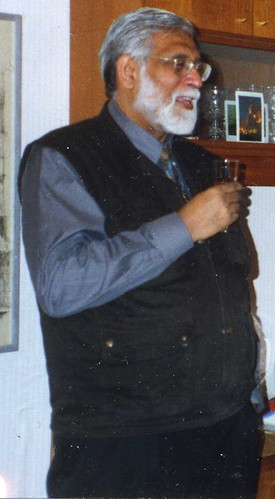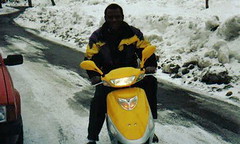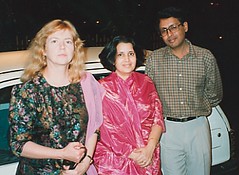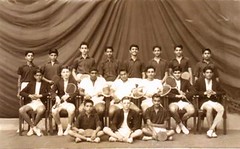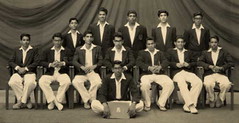I was not unduly surprised to get this note from Jack, the second Jake, in our midst:
"FYI I have had a Mac since the MACPlus. I have substantially upgraded my present machine (not a MACPlus!!) and help other Mac users with their problems. I even used a MAC laptop in my in house consulting on a Windows based network with no problems in the 1990's."
I made my entry into the Mac arena before the MacPlus when I got an Apple IIc for the Microelectronics Laboratory in 1984. Here are the specs of an Apple IIc with a picture of that machine which I bought from the University when it was auctioned off in 1994.
Apple IIc
Codename: ET, IIb, IIp, Pippin, VLC, Elf, Yoda, Teddy, Chels, Jason, Lollie
CPU: SynerTek 65C02 CPU Speed: 1 MHz (IIc)/4 MHz (IIc+)
FPU: none Bus Speed: 1 MHz (IIc)/4 MHz (IIc+)
Data Path: 8 bit ROM: 32 kB
Onboard RAM: 128 kB Maximum RAM: 1 MB
Monitor: Standard 9" Green monochrome, optional LCD panel.
Maximum Resolution: 40/80 text, 40x40 4-bit, 80x40 4-bit, 140x192 6-color, 280x192 1-bit, 140x192 4-bit, 560x192 1-bit
Floppy Drive: 140 kB 5.25" (IIc)/800 kB 3.5" (IIc+), floppy port
Serial: 2 Speaker(s): mono
Power: 18 Watts
Introduced: April 1984 Terminated: November 1990
The Apple IIc was the first compact computer.
I moved on the Mac 512, followed by the MacPlus, Mac SE and the Mac Portable. By then the rest of my laboratory staff had all followed my lead. We had Macs everywhere in use in critical applications in all the major research projects of the laboratory as the laser modification of integrated circuits and developing of high temperature superconductors and also to the normal desktop work of both staff and researchers.
I did not buy a home computer till 1991 December. I invested in a Mac PowerBook 170. I carried it with me on my work cum holiday trip to India in December 1991.
I can still remember when I was lecturing to a huge audience in a hotel in Madras, the power went off. Since I had the portable computer in front of me, the rest of the lecture was continued with my booming voice with my face showing up in the eerie computer light.
The active matrix black and white screen of the 170 is the best I have used. The 170 is still my most trusted machine. I have bought two of the same model from auction sites for a few Euros each and morphed them into one, with lots of spare parts available, so that it is ready my desktop always.
PowerBook 170
Codename: Road Warrior, Tim
CPU: Motorola MC68030 CPU Speed: 25 MHz
Bus Speed: 25 MHz Data Path: 32 bit
ROM: 1 MB
RAM Type: unique Minimum RAM Speed: 100 ns
Onboard RAM: 2 MB RAM Slots: 1
Maximum RAM: 8 MB
Level 1 Cache: 0.5 kB Screen: 10" Active Matrix
Maximum Resolution: 1 bit 640x400 Slots: modem
Floppy Drive: 1.4 MB SuperDrive Hard Disk: 40-80 MB
ADB: 1 Serial: 2
SCSI: HDI-30
Audio Out: mono 8 bit mini Audio In: mono 8 bit mini
Speaker(s): mono Gestalt ID: 21
Power: 17 Watts Weight: 6.8 lbs.
Dimensions: 2.25" H x 11.25" W x 9.3" D
Minimum OS: 7.0.1 Maximum OS: 7.6.1
Introduced: October 1991 Terminated: October 1992
(Technical information is from the Apple History Site.)
I have a couple of MacPluses on my storage shelves but they have been gracefully retired. I bought myself an iMac a few years ago. When a power surge blew that, the insurance company let me get a great eMac. This is my main computer today. However, also sitting on my table are also two of the very best vintage Macs, the model called Performa 6400. One is continuously playing music using Apple's great iTunes software. The other is used to keep me informed of the latest cricket scores, etc., while it also serves as my back-up computer. When audio commentary is available, it comes through this machine. (I don't have time to be sitting in front of a TV to watch anything!!)
All my computers are hooked together through my local Ethernet network and the PowerBook communicates to the others through AppleTalk.
I dictate a lot of my stuff into one of the machines. Another machine reads back to me much of what I want to read but never have the time.
People do not believe me when I say that my 1991 PowerBook 170 is faster than most of today's Window's computers. This is simply because it does not crash and it allows me to get my work done. No virus protection required, no email viruses, no bugs, no trojan horses to worry about.
But that is what computing is all about - getting a job done. And above all, most of the software that I run on my 1991 computer also runs on my latest computer as well, important things such as my permanent diary called "Remember", my "Address Book", etc.
So, if Jack is still using his Mac, then he is the "Californian" lemming that does not jump off the cliff!!
P.S. From Webster's Revised Unabridged Dictionary (1913):
Lemming \Lem"ming\ (l[e^]m"m[i^]ng), n. [Nor. lemming,
lemende; cf. Sw. lemel, Lapp. lummik.] (Zo["o]l.)
Any one of several species of small arctic rodents of the
genera Myodes and Cuniculus, resembling the meadow
mice in form. They are found in both hemispheres.
Note: The common Northern European lemming
(Myodes lemmus) is remarkable for making
occasional devastating migrations in enormous
numbers from the mountains into the lowlands.




